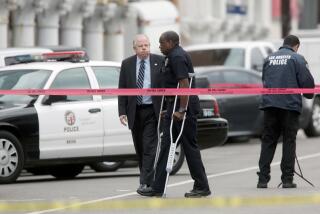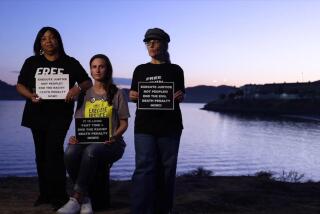Murder-for-Hire Case Goes to Another Jury : Trial: Michael Seawright, accused of paying two men to kill his mother-in-law 10 years ago in Hawthorne, is retried. Triggerman and accomplice were convicted.
After six weeks of tangled testimony, a jury on Thursday began weighing a 10-year-old murder-for-hire case that spawned four homicide prosecutions and has so far resulted in two convictions.
Nobody doubts that Catherine Stroup, 46, was murdered in her Hawthorne apartment the morning of April 5, 1983.
But what prompted the killing, and who did it and planned it, has been contested for the last six weeks in the trial of Michael Seawright, 39, who was tried for murder and conspiracy last year, although a jury could not reach a verdict.
With a new locale (the case was moved from Torrance to Pomona for scheduling reasons) and a new jury, Deputy Dist. Atty. Mike Duarte hopes much of the same evidence, largely circumstantial, will send Seawright to prison for life without the possibility of parole.
In closing arguments this week, Duarte portrayed Seawright as the greedy mastermind in a conspiracy to kill his mother-in-law--Stroup--and her husband, James Sr. The prosecuting attorney said Seawright hired two friends to kill the couple so he could gain control of the desert water delivery business that James Stroup Sr. bankrolled and Seawright managed.
Duarte told jurors to disregard the fact that James Stroup Sr. was originally charged with the murder of Catherine Stroup but acquitted in November, 1984, in a case that prosecutors now admit should never have been tried. Duarte said jurors should focus instead on what he described as Seawright’s manipulative, hypnotic personality. The defendant, he said, used the power of that personality to persuade two friends, brothers Peter and Paul Leach, to kill the Stroups on the promise that they would gain a stake in the water business and some insurance money.
Catherine Stroup, Duarte said, had been arguing with Seawright, whom she suspected of skimming profits from the water business, S&S; Water Co. of Twentynine Palms.
Peter Leach, the triggerman, was convicted in 1988 and sentenced to life in prison without parole. (An appellate court has since ordered a new penalty trial, which has yet to be scheduled.) Paul Leach pleaded guilty to second-degree murder in 1991 as part of a plea bargain compelling him to testify against Seawright. He was sentenced last May to 16 years to life in prison.
In testimony against Seawright, the Leaches said Seawright hired them to murder the Stroups. The brothers agreed to commit the crime, Duarte told jurors, because Seawright “has a hypnotic quality. It makes you want to do anything, or else . . . You remember James Stroup’s testimony: ‘He could con birds out of a tree.”’
Had he been home at the time of the murder, James Stroup would have been killed, too, Duarte said. But when the Leach brothers went to the Stroups’ apartment, they found only Catherine.
Paul Leach held her while Peter Leach placed a heart-shaped pillow over the muzzle of .22-caliber Luger and fired twice, hitting her in the chest and side. Paul Leach then let her collapse to the floor and Peter fired two more rounds into her head, killing her, Duarte said.
The two men scrambled out of a back window, Duarte said, and James Stroup found his wife dead when he returned home.
Seawright orchestrated the crime, providing the Leaches with Catherine Stroup’s gun and telling the Leaches how to kill her and where to find $2,000 stashed in a closet, Duarte said.
In the defense’s closing arguments, attorney Robert Alden Welbourn portrayed the state’s case as overblown. The Leach brothers, he said, went to Stroup’s apartment simply to commit a burglary, not as part of a grand conspiracy.
Welbourn said the investigation of his client got out of hand because detectives became frustrated when the district attorney originally refused to file charges against Seawright for lack of evidence, after arresting him in 1984.
Seawright was briefly detained following the arrest of the Leach brothers, who were picked up after the murder weapon was found and traced to them. He was arrested again in 1991 and charged with masterminding the murder.
“Never once has my client said ‘I did it. I was involved,’ ” Welbourn said. The defense attorney said that prosecutors have nothing but weak circumstantial evidence because the murder weapon was inadvertently destroyed in 1988 by the Los Angeles County Sheriff’s Department. “All the people have to go on is the innuendo, the impressions . . . “
Welbourn suggested that the lead investigator, Sheriff’s Department Sgt. Mike Lee, held a vendetta against Seawright because the case was originally rejected. Lee denies the claim.
Welbourn was barred by Superior Court Judge Clarence A. Stromwall from introducing evidence from Stroup’s trial. Welbourn wanted to introduce testimony from a witness who allegedly heard Stroup boast to friends that he could tell the grand jury, “I killed the bitch and there’s nothing they could do about it.”
In an interview, Stroup said Welbourn misconstrued his remark, which he made while drinking with friends shortly after his acquittal.
“I said ‘Wouldn’t it be a bitch if I went in there and said I killed her and they couldn’t do anything about it?’ ” Stroup said. “He took it out of context.”
Stromwall would not allow the remark to be introduced, deflating Welbourn’s strategy of casting suspicion on Stroup.
Welbourn urged jurors to disregard the Leach brothers’ testimony that they were hired by Seawright because they have changed their story several times over the years. He suggested that Peter Leach testified for the prosecution so that he could get a reduction on his sentence when it is reconsidered.
“That’s the leverage,” Welbourn said.
Seawright, he said, could not have had an interest in taking over the water business because it was not making much money. Furthermore, Welbourn said, Seawright loved Catherine and James Stroup.
“Why would anybody want to kill the Golden Gooses . . . ?” Welbourn asked. “It’s ridiculous.”
More to Read
Sign up for Essential California
The most important California stories and recommendations in your inbox every morning.
You may occasionally receive promotional content from the Los Angeles Times.










